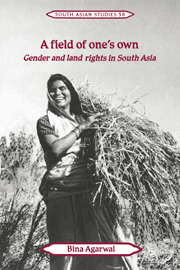Book contents
- Frontmatter
- Contents
- List of illustrations
- List of tables
- Preface
- Map 1.1 South Asia: provincial/state divisions
- 1 Land rights for women: making the case
- 2 Conceptualizing gender relations
- 3 Customary rights and associated practices
- 4 Erosion and disinheritance: traditionally matrilineal and bilateral communities
- 5 Contemporary laws: contestation and content
- 6 Whose share? Who claims? The gap between law and practice
- 7 Whose land? Who commands? The gap between ownership and control
- 8 Tracing cross-regional diversities
- 9 Struggles over resources, struggles over meanings
- 10 The long march ahead
- Definitions
- Glossary
- References
- Index
- Cambridge South Asian Studies
7 - Whose land? Who commands? The gap between ownership and control
Published online by Cambridge University Press: 14 January 2010
- Frontmatter
- Contents
- List of illustrations
- List of tables
- Preface
- Map 1.1 South Asia: provincial/state divisions
- 1 Land rights for women: making the case
- 2 Conceptualizing gender relations
- 3 Customary rights and associated practices
- 4 Erosion and disinheritance: traditionally matrilineal and bilateral communities
- 5 Contemporary laws: contestation and content
- 6 Whose share? Who claims? The gap between law and practice
- 7 Whose land? Who commands? The gap between ownership and control
- 8 Tracing cross-regional diversities
- 9 Struggles over resources, struggles over meanings
- 10 The long march ahead
- Definitions
- Glossary
- References
- Index
- Cambridge South Asian Studies
Summary
When my husband died, my neighours wanted my land. They beat me on any pretext, they tried to chase me out. Then they started to say I was having an affair with my brother-in-law, that was why I wouldn't leave despite their harassment. My homestead is like a jungle. I cannot grow any crops on it because my neighbours let their goats graze on my land. When I go to the bazaar, they steal what few crops I have.
(A Bangladeshi widow to Kabeer 1988:20)The gap between women's de jure and de facto ability to own land, discussed in chapter 6, is only half the story. The other, equally significant, half concerns the gap between ownership and control.
The issue of control has several dimensions, three principal ones (in the context of individual ownership) being the following: women's ability to retain title to the land they inherit or otherwise acquire; their ability to take decisions regarding the disposal of the land through sale, mortgage, bequest, or gift; and their ability to take decisions regarding the use of the land, including leasing it out or self-managing it, and disposing of its produce. By self-management I mean directly cultivating the land with one's own labour and/or cultivating it through hired labour under personal supervision. Each of these dimensions of control is important if women are to benefit from their land, and their advantage is greatest if they have control in all three ways.
Information
- Type
- Chapter
- Information
- A Field of One's OwnGender and Land Rights in South Asia, pp. 292 - 315Publisher: Cambridge University PressPrint publication year: 1995
